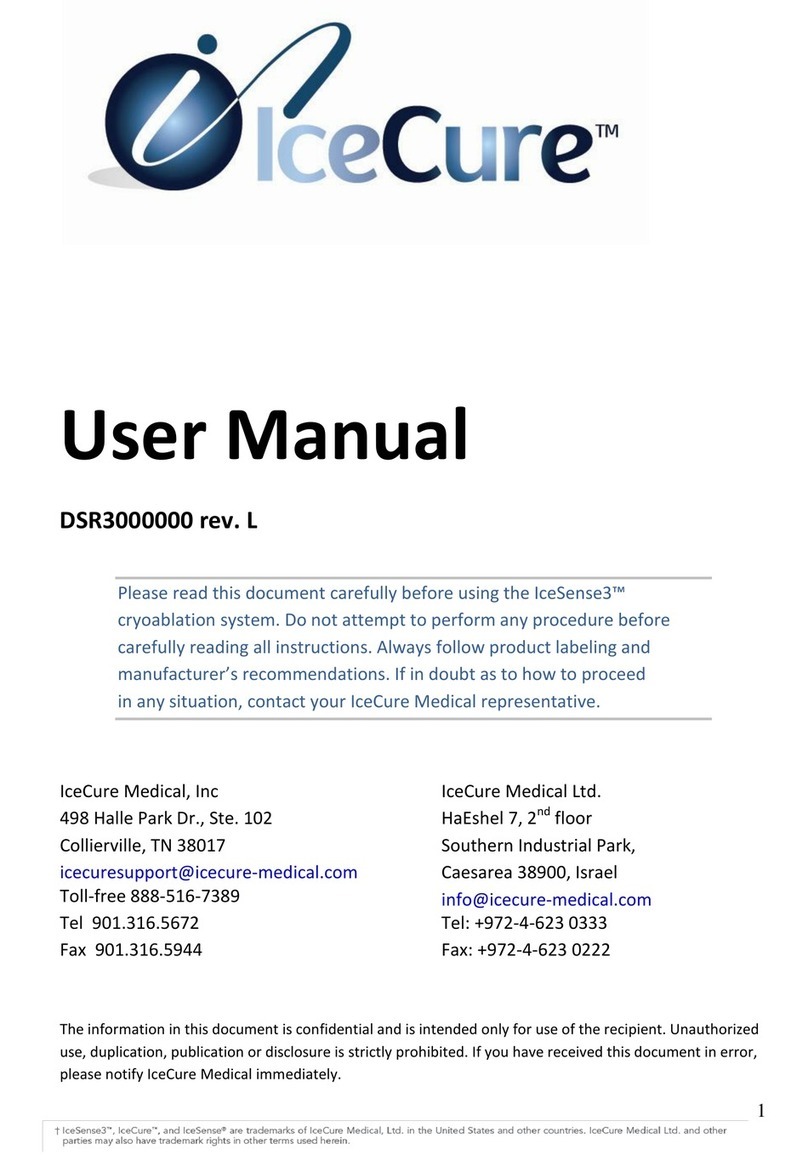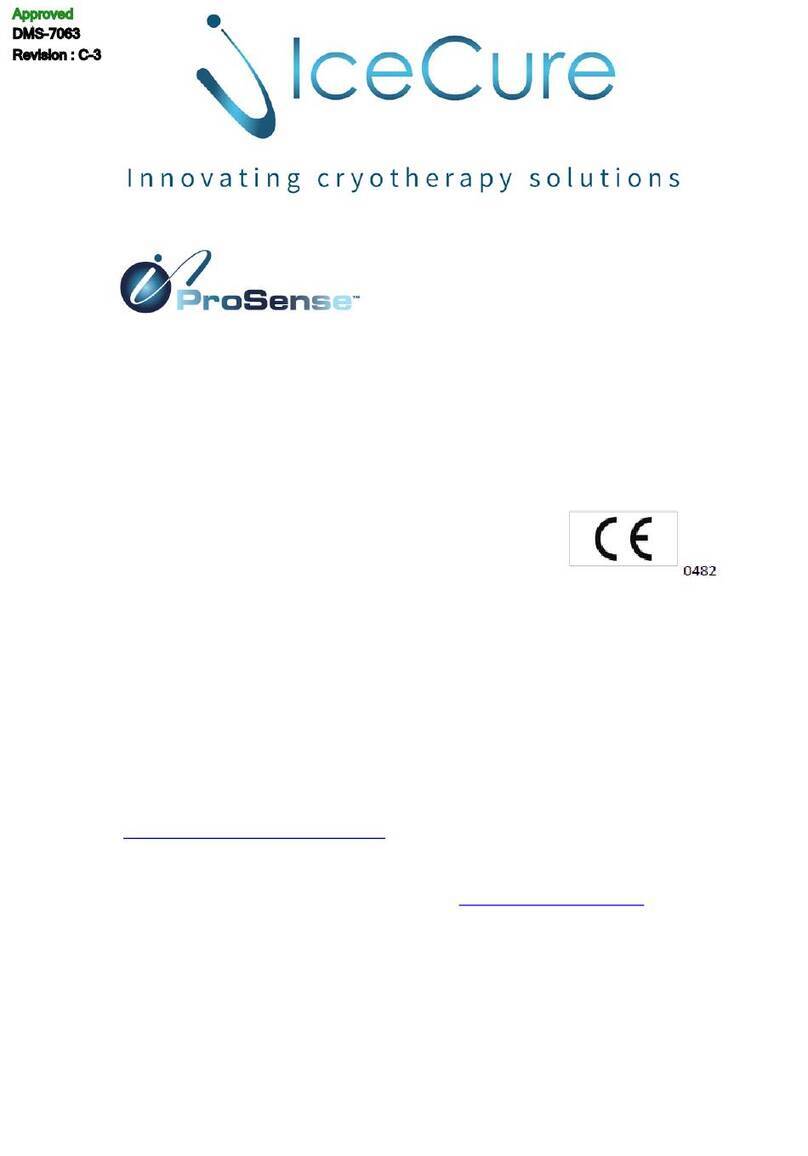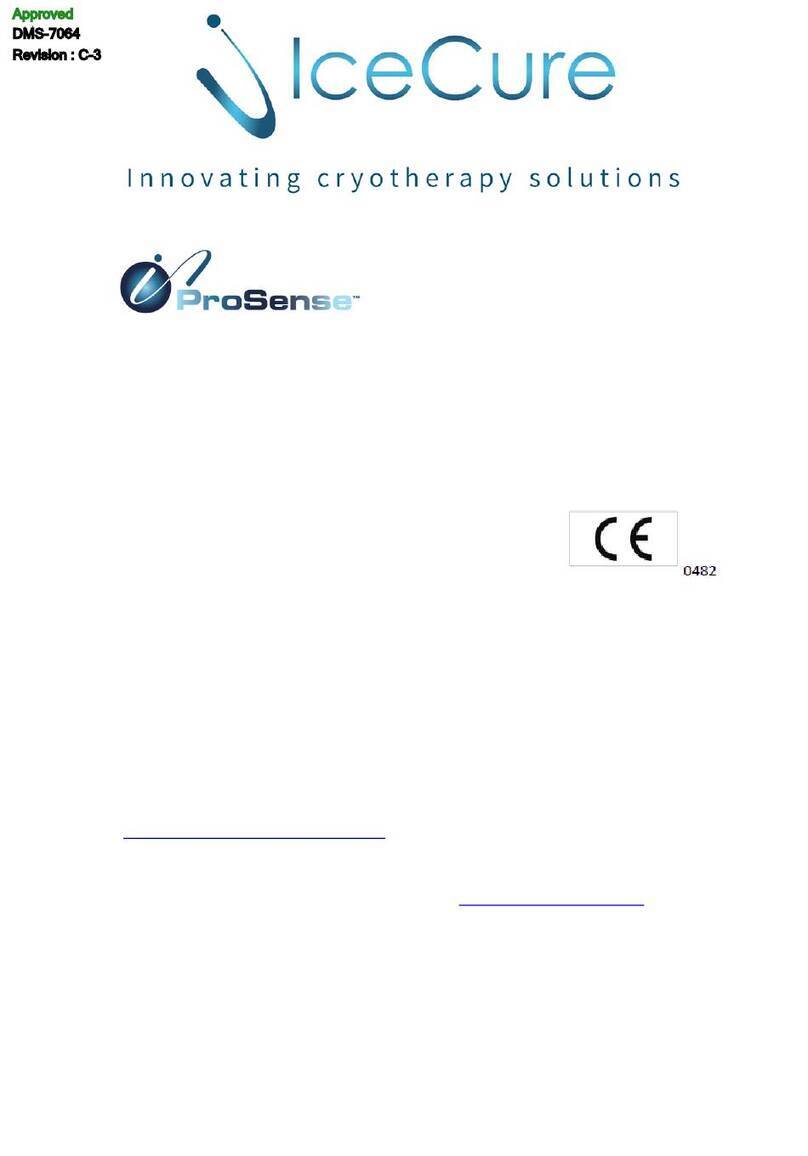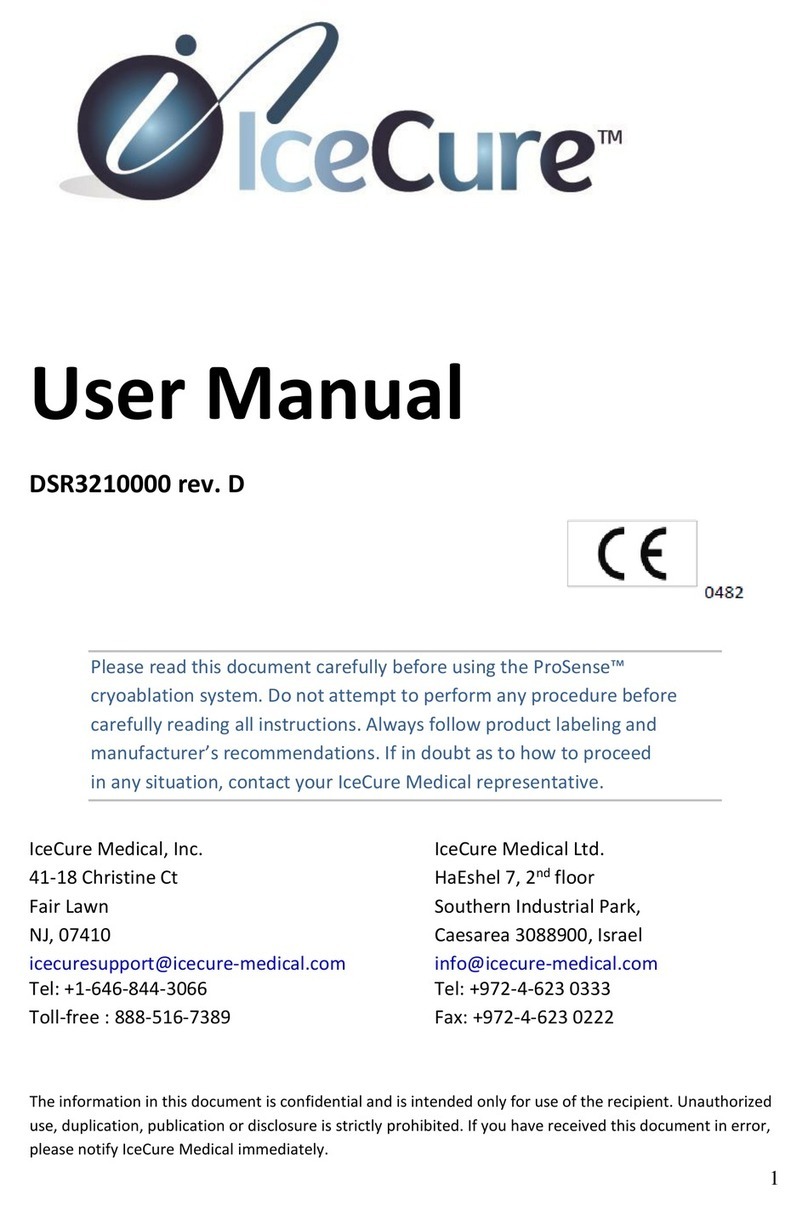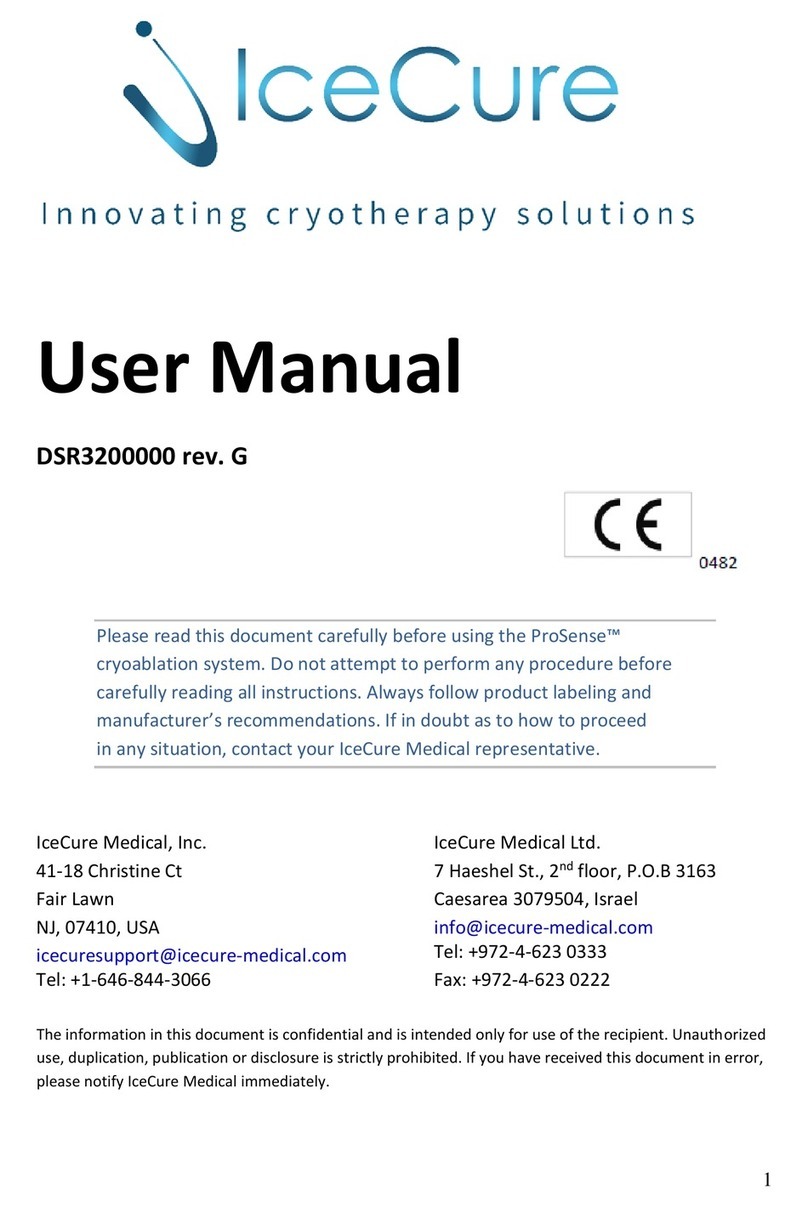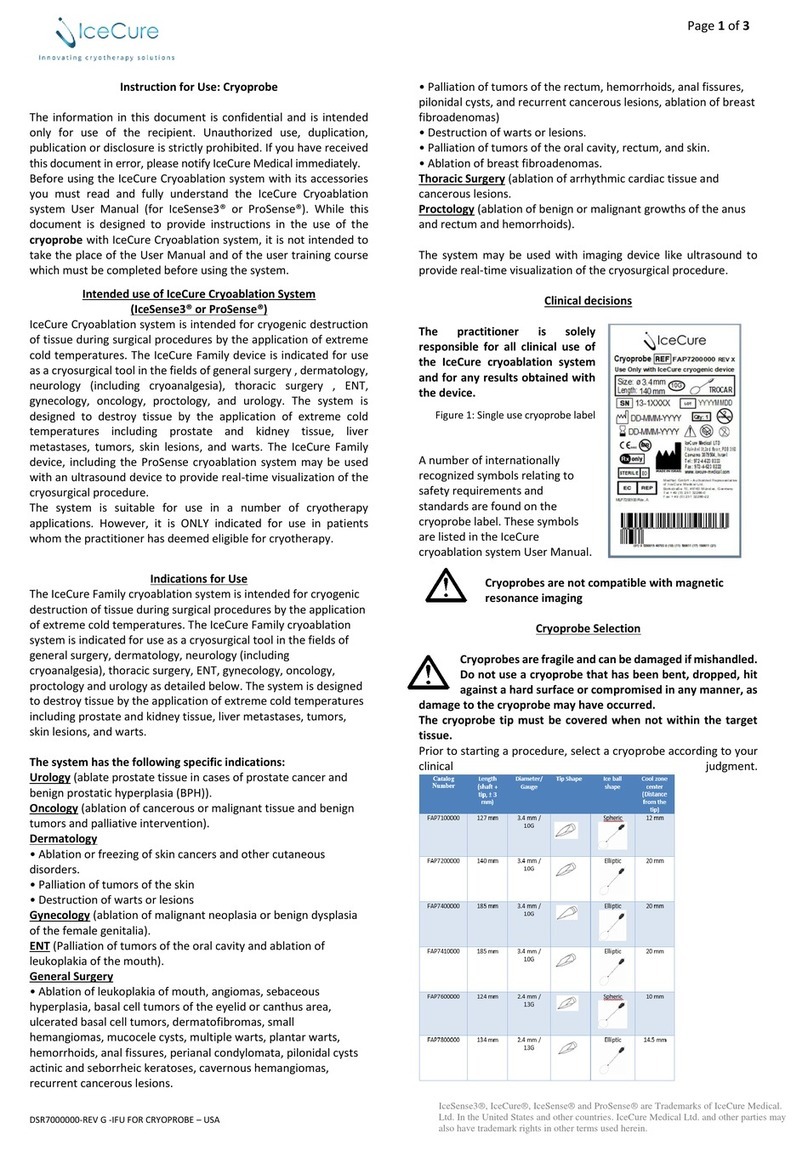Following each cryosurgical procedure, discard the single use
devices (single-use cryoprobe, single-use temperature sensor,
cryohandle, flexible hose and touch screen covers and sleeves).
All single use devices are considered to be medical waste and must
be disposed of in accordance with medical waste laws and hospital
standards. Sharp objects such as the cryoprobe and temperature
sensor must be disposed of in a sharp container.
The cryoprobes are single use and are suppliedin single
use packaging. Never reuse a single-use cryoprobe.
Reprocessing single use device (like the cryoprobe, temperature
sensor) could affect the mechanical or performance or
microbiological properties of the product.
Contraindications
Severe infection, uncorrectable coagulopathy, hemodynamic or
respiratory instability.
Predictable Adverse Events
General surgery/ Minimal Invasive Procedures - Mild/moderate
adverse events: infection, bleeding, pain, fever, thermal injury,
injury to adjacent organs, pneumonia, fall, internal adhesions,
incomplete treatment changes in the laboratory parameters-
elevation in aspartate aminotransferase and/ or alanine
aminotransferase level (this reflects hepatocellular damage),
minimal self-limited serum bilirubin level elevation, hemorrhage,
hematoma, myoglobinemia, pleural effusion, hemothorax,
pneumothorax, thrombosis, diarrhea, nausea, deep vein
thrombosis (DVT), transient ischemic attack, hypertension,
hypothermia, treatment site reaction, local neuropathy, frostbite,
skin burn, vagal reaction, vomiting, needle seeding, user accidental
injury. Severe adverse events: infection, thermal injury, procedure
done on the wrong patient/ part of the body, retention of foreign
object after surgery, pulmonary emboli, congestive heart failure,
stroke, fall, severe changes in the laboratory parameters-elevation
in aspartate aminotransferase and/ or alanine aminotransferase
(this reflects hepatocellular damage), life threatening serum
bilirubin level elevation, perirenal fluid collection, hemorrhage,
cryoshock (hypotension), respiratory compromise, multi organ
failure, disseminated intravascular coagulation (DIC), abscess,
pleural effusion, hemothorax, pneumothorax, thrombosis of the
portal vein branches, allergic/anaphylactoid reaction,
angina/coronary ischemia, myocardial infarction, arrhythmia,
atelectasis, adjacent organ injury.
Cryoablation procedure in general - Mild/moderate adverse
events: hematoma, hemorrhage, infection, pain, fever, thermal
injury, thrombocytopenia, coagulation dysfunction. Severe
adverse events: haemorrhage, infection, tumor seeding, thermal
injury, thrombocytopenia, coagulation dysfunction, parenchymal
or cryoablated organ injury, incorrect interpretation of post-cryo
changes, intra vessels / intra bone gas, emboli, myocardial
infarction.
Percutaneous ablation procedure - Mild/moderate adverse
events: percutaneous hematoma and bleeding infection, adjacent
organ injury, CT related adverse effects: radiation, elevated
creatinine and renal function injury, reaction. Severe adverse
events: percutaneous bleeding, infection, adjacent organ injury, CT
related adverse effects: radiation, acute renal injury, anaphylactic
shock in reaction to contrast agent admission, gas emboli.
Laparoscopic procedure - Mild/moderate adverse events: vascular
and visceral injury, general anesthesia related AE,
pneumoperitoneum (that can cause hemodynamic alterations),
post procedural abdominal adhesions, abdominal wall hematoma,
wound infection and fascial injury. Severe adverse events: vascular
and visceral injury, general anesthesia related AE, port site
metastasis, pneumoperitoneum (that can cause hemodynamic
alterations), post procedural abdominal adhesions, cryoprobe and
trocar insertion include injuries to major retroperitoneal vessels
and to bowel, abdominal wall hematoma, fascial dehiscence and
herniation, umbilical hernia, and umbilical wound infection.
Breast - Fibroadenoma and breast cancer: Mild/ moderate
adverse events: bleeding from breast puncture site, local breast
hematoma, local breast infection and thermal injury to the breast
skin, breast skin bruising, breast swelling, ecchymosis, edema, fat
necrosis. Severe adverse events: thermal injury.
Urology - Renal and Prostate: Mild/moderate adverse events:
adjacent organ injury, allergic reaction, bleeding, DVT, cystitis ,
Hematuria, hypotension, Idiosyncratic reaction, ileus, infection,
pleural effusion, pneumothorax, probe site paresthesia, mild renal
failure, renal infract, voiding dysfunction, urinary tract obstruction,
hematomas, ejaculatory dysfunction, erectile dysfunction, penile
paresthesia, pelvic pain, perineal pain. Severe adverse events:
abscess, adjacent organ injury, renal artery/renal vein injury,
anaphylactic reaction, coronary ischemia, myocardial infraction,
bleeding, death, DVT, hypotension, pulmonary embolism, severe
renal failure, stroke, Idiosyncratic reaction, ileus, infection lumbar
radiculopathy, pelvic vein thrombosis, pleural effusion,
pneumothorax, renal hemorrhage , severe urinary tract
obstruction, renal vein thrombosis, rectourethral fistula, scrotal
edema, ureteral stricture, renal infract, sepsis, urinary tract leak,
urethral sloughing, urethral stricture, urinary fistula, urinary
frequency/urgency, urinary incontinence, urinary retention,
bladder neck contracture, stroke, need for transfusion due to
hemorrhage, tumor seeding, gastro intestinal tract injury.
Thoracic surgery - Lung and cardiac arrhythmia: Mild/moderate
adverse events: frostbite, respiratory failure, pneumothorax,
Hemothorax, pleural effusion, pneumonia, empyema, hemoptysis,
lung collapse, thrombosis, phrenic nerve palsy, Pain, fever, cough,
back pain, skin injury, pulmonary emboli, Loss of speech
(temporary aphasia from laryngeal nerve damage), arm paresis,
burn, hemorrhage, pneumonitis. Severe adverse events:
respiratory failure/arrest, pneumothorax, hemothorax, pleural
effusion, pneumonia, empyema, lung collapse, thrombosis, phrenic
nerve palsy, subcutaneous emphysema, death due to Acute
respiratory distress syndrome, pulmonary emboli, prolonged chest
tube drainage, prolonged intubation pulmonary
insufficiency/failure, hemorrhage, dyspnea, atelectasis.
Liver - Mild/moderate adverse events: changes in the laboratory
parameters-elevation in AST (Aspartate Aminotransferase) and/ or
ALN (Alanine aminotransferase) level - reflects hepatocellular
damage of normal liver parenchyma, minimal self- limited serum
bilirubin level elevation, hematoma, hemorrhage, nyoglobinemia,
pleural effusion, hemothorax, pneumothorax, thrombosis. Severe
adverse events: Severe changes in the laboratory parameters-
elevation in AST (aspartate aminotransferase) and/ or ALN (Alanine
aminotransferase) level - reflects hepatocellular damage of normal
liver parenchyma, life threatening serum bilirubin level elevation,
hemorrhage, cryoshock (hypotension, respiratory compromise,
multi organ failure, DIC), post procedural abscess- due to conduit
ascending bacterial (especially in patients with history of biliary
interventions and biliary enteric anastomosis ), pleural effusion,
hemothorax, pneumothorax, hrombosis of the portal vein
branches.
Musculoskeletal - Mild/moderate adverse events: muscular injury,
pain, swelling, osteonecrosis, osteomyelitis, chondrolysis, nerve
palsy, motor dysfunction, peri-ablational neuropathies. Severe
adverse events: compartment syndrome osteonecrosis,
osteomyelitis, chondrolysis, nerve palsy, motor dysfunction, peri-
ablational neuropathies, bowel damage, urinary tract damage,






